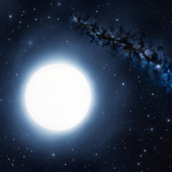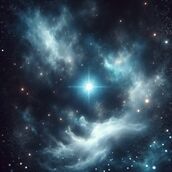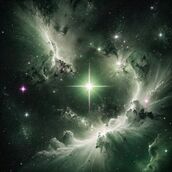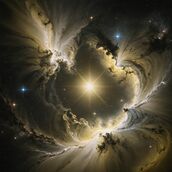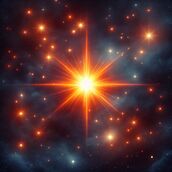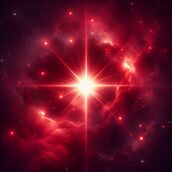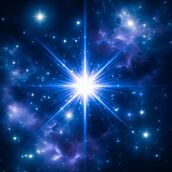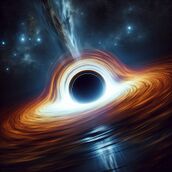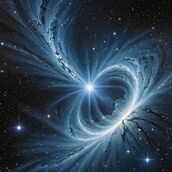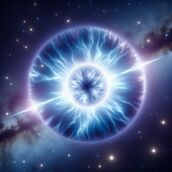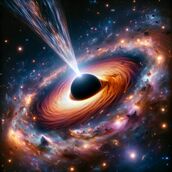More actions
No edit summary |
Add combat effects to table |
||
| Line 4: | Line 4: | ||
!Type | !Type | ||
!Resources | !Resources | ||
!Combat Effects | |||
!Description | !Description | ||
|- | |- | ||
| Line 9: | Line 10: | ||
|A | |A | ||
|{{icon|energy}}1-3 | |{{icon|energy}}1-3 | ||
| | |||
|A white star that is hotter and brighter than the Sun. It has a shorter lifespan than the Sun and emits ultraviolet radiation that can be harmful to life on nearby planets. | |A white star that is hotter and brighter than the Sun. It has a shorter lifespan than the Sun and emits ultraviolet radiation that can be harmful to life on nearby planets. | ||
|- | |- | ||
| Line 14: | Line 16: | ||
|B | |B | ||
|{{icon|energy}}2-3 | |{{icon|energy}}2-3 | ||
| | |||
|A blue star that burns very hot and bright, but has a relatively short lifespan. It emits high-energy radiation that can be harmful to nearby planets and spacecraft. | |A blue star that burns very hot and bright, but has a relatively short lifespan. It emits high-energy radiation that can be harmful to nearby planets and spacecraft. | ||
|- | |- | ||
| Line 19: | Line 22: | ||
|F | |F | ||
|{{icon|energy}}1-2 | |{{icon|energy}}1-2 | ||
| | |||
|A yellow-white star that is slightly hotter and brighter than the Sun. It has a longer lifespan and is more stable than the Sun. | |A yellow-white star that is slightly hotter and brighter than the Sun. It has a longer lifespan and is more stable than the Sun. | ||
|- | |- | ||
| Line 24: | Line 28: | ||
|G | |G | ||
|{{icon|energy}}1-2 | |{{icon|energy}}1-2 | ||
| | |||
|A yellow star like our Sun. It is relatively stable and has a long lifespan, making it a good candidate for hosting habitable planets. | |A yellow star like our Sun. It is relatively stable and has a long lifespan, making it a good candidate for hosting habitable planets. | ||
|- | |- | ||
| Line 29: | Line 34: | ||
|K | |K | ||
|{{icon|energy}}1 | |{{icon|energy}}1 | ||
| | |||
|An orange star that is cooler and less luminous than the Sun. It has a long lifespan but emits less energy than the Sun, which can make it difficult for planets to maintain a habitable temperature. | |An orange star that is cooler and less luminous than the Sun. It has a long lifespan but emits less energy than the Sun, which can make it difficult for planets to maintain a habitable temperature. | ||
|- | |- | ||
| Line 34: | Line 40: | ||
|M | |M | ||
|{{icon|energy}}1 | |{{icon|energy}}1 | ||
| | |||
|A red star that is the most common type of star in the galaxy. It is relatively cool and dim, with a long lifespan. Planets in the habitable zone of a Class-M star would be close to the star and would likely be tidally locked, with one side always facing the star. | |A red star that is the most common type of star in the galaxy. It is relatively cool and dim, with a long lifespan. Planets in the habitable zone of a Class-M star would be close to the star and would likely be tidally locked, with one side always facing the star. | ||
|- | |- | ||
| Line 39: | Line 46: | ||
|O | |O | ||
|{{icon|energy}}6-8 | |{{icon|energy}}6-8 | ||
| | |||
|A rare and very hot blue star that is much larger and more massive than the Sun. It emits intense ultraviolet radiation and has a short lifespan. | |A rare and very hot blue star that is much larger and more massive than the Sun. It emits intense ultraviolet radiation and has a short lifespan. | ||
|- | |- | ||
| Line 44: | Line 52: | ||
|Black Hole | |Black Hole | ||
|{{icon|science}}2-4 | |{{icon|science}}2-4 | ||
|{{Iconify|speed|3=-25% Speed|4={{red}}}} | |||
|A region of space where the gravitational pull is so strong that nothing, not even light, can escape. Black holes form when massive stars collapse in on themselves. | |A region of space where the gravitational pull is so strong that nothing, not even light, can escape. Black holes form when massive stars collapse in on themselves. | ||
|- | |- | ||
| Line 49: | Line 58: | ||
|Pulsar | |Pulsar | ||
|{{Icon|energy}}1-2{{icon|science}}1-2 | |{{Icon|energy}}1-2{{icon|science}}1-2 | ||
|{{Iconify|shields|3=-100% Shields|4={{red}}}} | |||
|A highly magnetized, rotating neutron star that emits beams of electromagnetic radiation. Pulsars were first observed as objects emitting regular pulses of radio waves. | |A highly magnetized, rotating neutron star that emits beams of electromagnetic radiation. Pulsars were first observed as objects emitting regular pulses of radio waves. | ||
|- | |- | ||
| Line 54: | Line 64: | ||
|Neutron Star | |Neutron Star | ||
|{{Icon|energy}}1-2{{icon|science}}1-2 | |{{Icon|energy}}1-2{{icon|science}}1-2 | ||
|{{Iconify|speed|3=-25% Speed|4={{red}}}} | |||
|The collapsed core of a massive star that has gone supernova. Neutron stars are incredibly dense, with a mass greater than the Sun packed into a sphere just a few kilometers in diameter. | |The collapsed core of a massive star that has gone supernova. Neutron stars are incredibly dense, with a mass greater than the Sun packed into a sphere just a few kilometers in diameter. | ||
|- | |- | ||
| Line 59: | Line 70: | ||
|White Dwarf | |White Dwarf | ||
|{{Icon|power}}1 | |{{Icon|power}}1 | ||
| | |||
|The remnant core of a low-mass star that has exhausted all of its nuclear fuel. White dwarfs are small and dense, with a mass similar to the Sun but a size comparable to Earth. They emit little energy and eventually cool to become a "black dwarf." | |The remnant core of a low-mass star that has exhausted all of its nuclear fuel. White dwarfs are small and dense, with a mass similar to the Sun but a size comparable to Earth. They emit little energy and eventually cool to become a "black dwarf." | ||
|- | |- | ||
| Line 64: | Line 76: | ||
|Supermassive Black Hole | |Supermassive Black Hole | ||
|{{Icon|power}}5{{Icon|science}}5-10 | |{{Icon|power}}5{{Icon|science}}5-10 | ||
| | |||
|A supermassive black hole, residing at the center of galaxies, exerts an irresistible gravitational force, ensnaring even light within its inescapable grasp. Seizing control of the supermassive black hole at the heart of the galaxy bestows unparalleled dominion to the star empire, wielding influence over the cosmic fabric and commanding strategic advantages that can tip the balance of power in their favour. | |A supermassive black hole, residing at the center of galaxies, exerts an irresistible gravitational force, ensnaring even light within its inescapable grasp. Seizing control of the supermassive black hole at the heart of the galaxy bestows unparalleled dominion to the star empire, wielding influence over the cosmic fabric and commanding strategic advantages that can tip the balance of power in their favour. | ||
|} | |} | ||
Revision as of 07:38, 19 July 2024
Stars are the largest celestial bodies in the galaxy, and form the center of a star system where planets orbit around.
